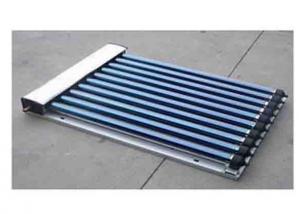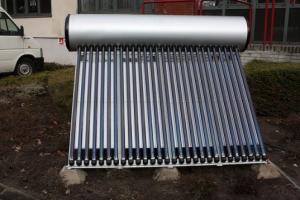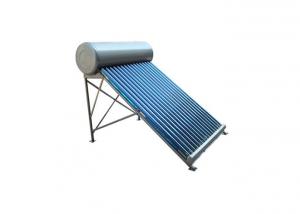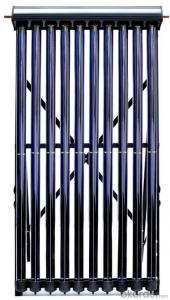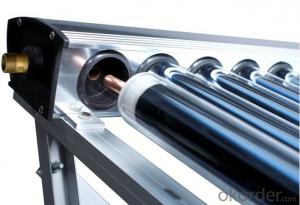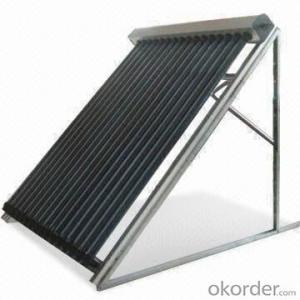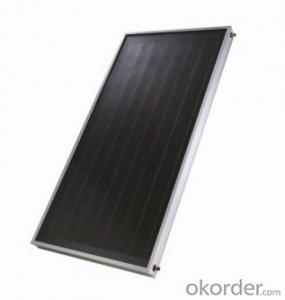I5 Solar Collectors Eccentric Heat Pipe Vacuum Tube SC-HE
- Loading Port:
- Shanghai
- Payment Terms:
- TT OR LC
- Min Order Qty:
- 20 set
- Supply Capability:
- 200 set/month
OKorder Service Pledge
OKorder Financial Service
You Might Also Like
1. Structure of Eccentric Heat Pipe Vacuum Tube Solar Collector Model SC-HE
This product is composed of the following parts:
1 Manifold 
2 Collector Joint
3 All aluminum alloy shell and frame
4 All Glass Vacuum Tube , with reflection mirror sealed in
5 Tube Holder
6 Wind Feet
2. Main Features of Eccentric Heat Pipe Vacuum Tube Solar Collector Model SC-HE
Double ratio of light concentration, the temperature inside the tube is 30% higher than the normal tubes.
Superconducting copper heat pipe and large heat transfer area of the condensing end with high power of heat transfer and fast speed of start working.
The reflection mirror can avoid the effects from external environment and ensure that the mirror reflectivity is not reduced.
All aluminum alloy shell and frame with oxidation and coating anti-corrosion surface, corrosion resistance, easy to be installed.
The thermal insulation layer with rock wool/glass wool that can resistant high temperature, compression molding, high density, small coefficient of thermal conductivity.
Copper pipe with high purity and quality, pressure and corrosion resistance, can stand 1MPa.The gravity heat pipe transfers heat by one way, high heat collecting efficiency but low heat lost.
3. Eccentric Heat Pipe Vacuum Tube Solar Collector Model SC-HE Images

4. Eccentric Heat Pipe Vacuum Tube Solar Collector Model SC-HE Specifications
Model | SC-HCM-10 | SC-HCM-15 | SC-HCM-18 | SC-HCM-20 | SC-HCM-24 | SC-HCM-25 | SC-HCM-30 |
Tube Qty(pcs) | 10 | 15 | 18 | 20 | 24 | 25 | 30 |
Tube Pitch(㎜) | 90 | 90 | 90 | 90 | 90 | 90 | 90 |
Tube Diameter/ Length(㎜) | φ70/2000 | φ70/2000 | φ70/2000 | φ70/2000 | φ70/2000 | φ70/2000 | φ70/2000 |
Vacuum Tube Material | high borosilicate glass 3.3 | high borosilicate glass 3.3 | high borosilicate glass 3.3 | high borosilicate glass 3.3 | high borosilicate glass 3.3 | high borosilicate glass 3.3 | high borosilicate glass 3.3 |
Thickness of Inner Tube/Outer Tube(㎜) | 1.6/2.0 | 1.6/2.0 | 1.6/2.0 | 1.6/2.0 | 1.6/2.0 | 1.6/2.0 | 1.6/2.0 |
Condensator Diameter/ Length(㎜) | φ14/1900 | φ14/1900 | φ14/1900 | φ14/1900 | φ14/1900 | φ14/1900 | φ14/1900 |
Heat Pipe Material / Thickness(㎜) | Copper tp2/0.6 | Copper tp2/0.6 | Copper tp2/0.6 | Copper tp2/0.6 | Copper tp2/0.6 | Copper tp2/0.6 | Copper tp2/0.6 |
Copper Pipe Diameter/ Thickness | φ35/1.0 | φ35/1.0 | φ35/1.0 | φ35/1.0 | φ35/1.0 | φ35/1.0 | φ35/1.0 |
Joint Specification | φ22 Or 3/4″ | φ22 Or 3/4″ | φ22 Or 3/4″ | φ22 Or 3/4″ | φ22 Or 3/4″ | φ22 Or 3/4″ | φ22 Or 3/4″ |
Insulation Material/ Thickness(㎜) | Rock Wool/40 | Rock Wool /40 | Rock Wool /40 | Rock Wool/40 | Rock Wool /40 | Rock Wool /40 | Rock Wool /40 |
Rated Pressure(MPa) | 0.6 | 0.6 | 0.6 | 0.6 | 0.6 | 0.6 | 0.6 |
Working Temperature(℃) | <120 | <120 | <120 | <120 | <120 | <120 | <120 |
Capacity(L) | 0.89 | 1.26 | 1.48 | 1.63 | 1.93 | 2.00 | 2.37 |
Collecting Area(㎡) | 1.37 | 2.05 | 2.46 | 2.73 | 3.28 | 3.41 | 4.10 |
Gross Area(㎡) | 2.01 | 2.98 | 3.56 | 3.95 | 4.72 | 4.91 | 5.88 |
Referral Traffic(L/min) | 1.06 | 1.49 | 1.79 | 2.0 | 2.4 | 2.5 | 3.0 |
Pressure Drop(Pa) | 16.24 | 41.4 | 63.4 | 81.7 | 127.2 | 140.1 | 219.8 |
Intercept Efficiencyη0 | 0.77 | 0.77 | 0.77 | 0.77 | 0.77 | 0.77 | 0.77 |
Heat Loss Coefficient a W/㎡℃ | 1.9 | 1.9 | 1.9 | 1.9 | 1.9 | 1.9 | 1.9 |
Powe(W)1000W/㎡Irradiation | 744 | 1044 | 1256 | 1398 | 1681 | 1748 | 2098 |
40.25 | 52.75 | 61.75 | 66.75 | 81.00 | 85.35 | 100.70 | |
a (㎜) | 1115 | 1615 | 1915 | 2115 | 2515 | 2615 | 3115 |
b (㎜) | 1025 | 1525 | 1825 | 2025 | 2425 | 2525 | 3025 |
c (㎜) | 950 | 1450 | 1750 | 1950 | 2350 | 2450 | 2950 |
c/2 (㎜) | —— | —— | 875 | 975 | 1175 | 1225 | 1475 |
d (㎜) | 2150 | 2150 | 2150 | 2150 | 2150 | 2150 | 2150 |
e (㎜) | 1375 | 1240 | 1240 | 1240 | 1240 | 1240 | 1240 |
f (㎜) | 1590 | 1590 | 1590 | 1590 | 1590 | 1590 | 1590 |
5. FAQ
1. Can the solar collector be used in cold condition?
Re: This solar collectors can be used in temperatures as low as -30℃, although performance is greatly reduced in such extreme conditions. Good heat output is still achieved in mild sub-zero conditions.
2. What maintenance of the solar collector is required?
Re: Under normal circumstances no maintenance of the system is required. Due to the shape of the tubes regular rainfall and wind should keep the tubes clean. Should a tube even be broken it should be replaced. This, however, is an inexpensive and easy job. Any "handy" person can install a new tube (while adhering to local health and safety regulations). Our solar collectors can operate with several broken tubes, however the efficiency will be reduced slightly.
- Q: How much space is required for a solar collector installation?
- The space required for a solar collector installation can vary depending on the size and type of the collector system. Generally, a typical residential solar collector installation can require around 100 to 400 square feet of roof space, while larger commercial or industrial installations may require several thousand square feet of land or roof space. It is important to consult with a solar professional to determine the specific space requirements for a particular installation.
- Q: Can solar collectors be used for heating ice melting systems?
- Yes, solar collectors can be used for heating ice melting systems. Solar thermal collectors can absorb and convert sunlight into heat, which can then be used to warm a fluid or heat transfer medium that circulates through pipes or tubes in the ice melting system. This heated fluid can then be used to melt ice or prevent ice formation on surfaces such as roads, driveways, or walkways.
- Q: Are there any noise or pollution concerns associated with solar collectors?
- No, solar collectors do not produce noise or pollution as they generate electricity by harnessing sunlight, a clean and renewable energy source.
- Q: Are there any aesthetic considerations with solar collectors?
- Yes, there are aesthetic considerations with solar collectors. The appearance of solar collectors can vary depending on the design, size, and placement. Some people may find them visually intrusive or not aesthetically pleasing, particularly if they are large or mounted on rooftops. Therefore, it is important to consider the visual impact and integration of solar collectors into the overall design and architecture of the surrounding environment.
- Q: Can solar collectors be used for heating oil and gas facilities?
- Yes, solar collectors can be used for heating oil and gas facilities. Solar thermal systems can be employed to heat water or other fluids that are used for various processes in oil and gas facilities, such as heating or steam generation. This can help reduce the reliance on traditional fossil fuel-based heating systems and contribute to the overall sustainability and energy efficiency of the facilities.
- Q: Are solar collectors suitable for shopping malls and retail centers?
- Yes, solar collectors are suitable for shopping malls and retail centers. They can help reduce energy costs and carbon footprints by harnessing renewable energy from the sun. Additionally, the large rooftop spaces available in shopping malls and retail centers provide ample space for installing solar panels, making it a viable option for sustainable energy generation.
- Q: Can solar collectors be used for desalination purposes?
- Yes, solar collectors can be used for desalination purposes. Solar thermal desalination systems utilize solar energy to heat water, creating steam that is then condensed to produce fresh water. This process is known as solar desalination and offers a sustainable and environmentally friendly solution for converting seawater into potable water. By harnessing the power of the sun, solar collectors can effectively drive the desalination process and provide a viable option for addressing water scarcity in coastal regions.
- Q: Can solar collectors be used for heating waste management facilities?
- Yes, solar collectors can be used for heating waste management facilities. Solar thermal systems can be installed to capture and convert solar energy into heat, which can then be used for various applications including heating waste management facilities. This can help reduce the reliance on traditional energy sources and decrease the carbon footprint of these facilities.
- Q: Can solar collectors be used for heating water for agricultural purposes?
- Yes, solar collectors can be used for heating water for agricultural purposes. Solar water heating systems can be installed to provide hot water for various agricultural applications such as livestock watering, greenhouse irrigation, and crop drying. These systems harness the sun's energy to heat water, thereby reducing the reliance on fossil fuels and minimizing operational costs for farmers.
- Q: What is the principle of centralized solar water heater? pros and cons?
- The solar tube in the solar collector absorbs the solar radiation energy, converts the solar radiation energy into heat energy to heat the water in the collector, the heated high temperature water
Send your message to us
I5 Solar Collectors Eccentric Heat Pipe Vacuum Tube SC-HE
- Loading Port:
- Shanghai
- Payment Terms:
- TT OR LC
- Min Order Qty:
- 20 set
- Supply Capability:
- 200 set/month
OKorder Service Pledge
OKorder Financial Service
Similar products
Hot products
Hot Searches






